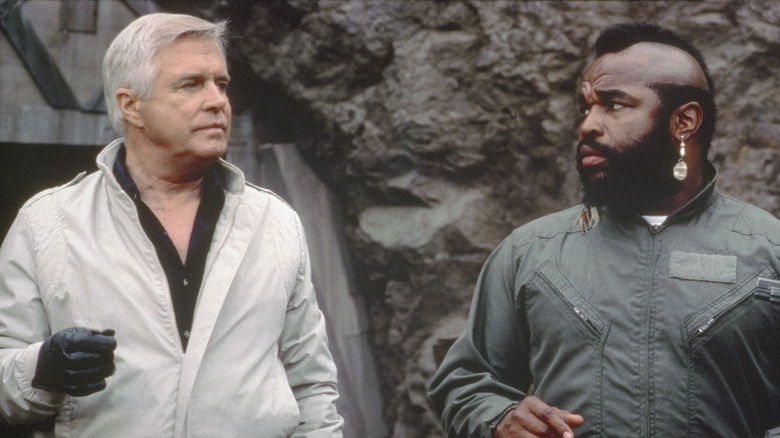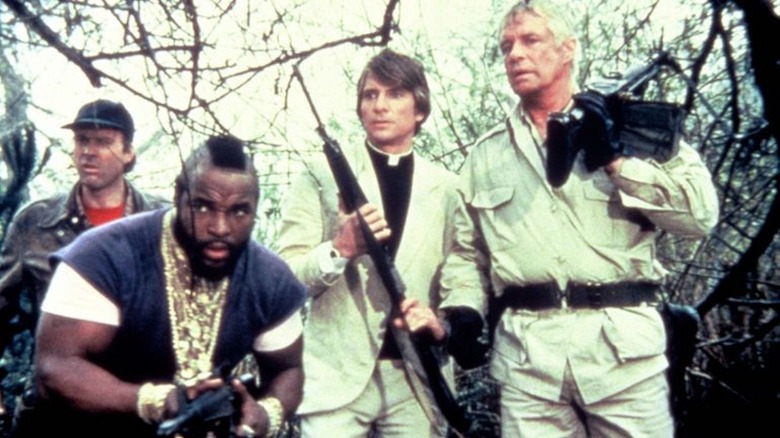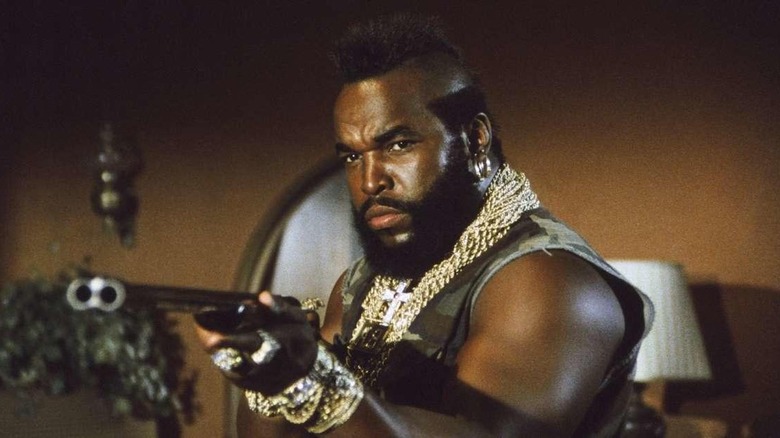The Creators Of The A-Team Were Forced To Agree To One Rule To Air During Prime Time [Exclusive]
The 1980s were a junky era for film and television. Once the studios and networks figured out what kinds of formulas American audiences were keen on after Vietnam, Watergate, and the election of Ronald Reagan reshaped the country's psyche, they exploited them relentlessly. One particularly reliable genre of sorts was the gung-ho, men-on-a-mission actioner where outnumbered, yet armed-to-the-teeth heroes (or, in the case of Sylvester Stallone's John Rambo, solitary hero) resourcefully defeated equally well-armed bad guys.
When these projects were made for the big screen, studios piled on the red meat. Scads of folks got shot, stabbed, and blown up, and the directors didn't skimp on the viscera. These were the hardest of the hard R-rated movies of the decade, and they made heaps of money.
At a network level, television was still cinema's less-appreciated little brother in the 1980s. Sitcoms were king, while hour-long dramas tended toward soapiness or murder-of-the-week mysteries. There were very fine shows that worked within these parameters, but ambitious executives like NBC's Brandon Tartikoff (who was charged with reversing the struggling network's fortunes) were obsessed with pushing the medium forward. They wanted to make series that challenged films in terms of quality writing and, if possible, physical scale.
Tartikoff succeeded tremendously in this regard. He helped redefine adult-skewing dramas by airing smart, stylish shows like "St. Elsewhere," "Miami Vice," and "L.A. Law." He built the first Must-See TV lineup with "The Cosby Show," "Family Ties," "Cheers," "Night Court" and "Hill Street Blues."
But Tartikoff was no snob. He was willing to milk any entertainment trend if there was a hit series in it. That's how "The A-Team" came to be. The show's origins were in the macho, militarized fiction of the era (e.g. "First Blood," James Glickenhaus' "The Soldier" and Don Pendleton's Mack Bolan books). It flaunted state-of-the-art weaponry and loads of explosions. But it couldn't go as hard as the works that inspired it, which turned it into the silliest, most strangely endearing hour-long series of the '80s.
All the weaponry of Rambo, but none of the death
Centered on the exploits of a Vietnam commando unit imprisoned for a crime they didn't commit (if you grew up in the '80s, you should be able to recite the opening narration verbatim), "The A-Team" hooked viewers via its appealing ensemble: George Peppard as the military mastermind Hannibal, Dirk Benedict as the wily Face, Dwight Schultz as the legally insane pilot "Howling Mad" Murdock and Mr. T as the surly enforcer B.A. Baracus. But creators Stephen J. Cannell and Frank Lupo were hot to capitalize on (mostly male) Americans' chest-puffing, gun-crazy overreaction to the bloody humbling of the Vietnam War.
Tartikoff knew there was a huge market for "The A-Team," but he was up against network censors who couldn't let much more than a paper cut make it to air. The guns and explosions were fine, but it had to be, uh, good clean warfare.
His solution was the stuff of oddball television history.
I had the pleasure of interviewing "Leprechaun" director Mark Jones for /Film recently, and, prior to creating an unlikely horror franchise, he was a part of "The A-Team" writing collective that, from 1983 to 1987, had to deliver bloodless gunplay to viewers every Tuesday night in Prime Time. How did they pull that off?
An A-Team with F-grade aim
Save for very rare circumstances, no one ever got killed on "The A-Team." On the odd occasion that one of the four principals got injured, they usually showed up at the end of the episode in a sling. How did this work? According to Jones:
"Here was the deal: It was NBC and it was eight o'clock. [NBC head] Brandon Tartikoff bought the show that Frank and Steve created. And they said, 'We need these guys to have guns and machine guns and all that stuff.' It was different times in the '80s. They said, 'Okay, we'll let you have all the shooting and all the explosions, but you can't kill anybody.' So if you notice, they would shoot and the car would flip over and then they'd always cut to the guys crawling out because they didn't want anybody to die. It was kind of funny. It was a live-action cartoon. No one died, and that was because NBC said, 'The only way you can have shooting at eight o'clock is you can't kill anybody.'"
I watched the show religiously during its Nielsen ratings prime (i.e. the first three seasons before the series hemorrhaged viewers and got canceled in 1987), and was too charmed by the quartet to be bothered by its lack of carnage. In retrospect, it's probably a not-so-great thing that a generation of Gen Xers were entranced by non-fatal volleys of machine-gun fire (unless they were shooting at a car's gas tank, everyone on the show possessed the aim of a "Star Wars" Stormtrooper), but the gore-drenched movies that inspired the series were readily available on pay cable and at video stores. I wasn't sheltered. I knew "The A-Team" was, as Jones said, a live-action cartoon, and I'll always love it for that.


